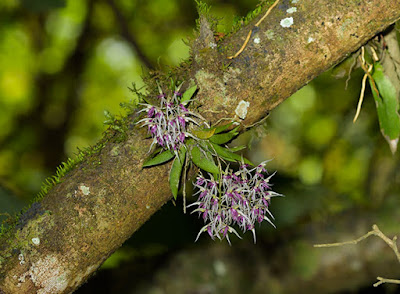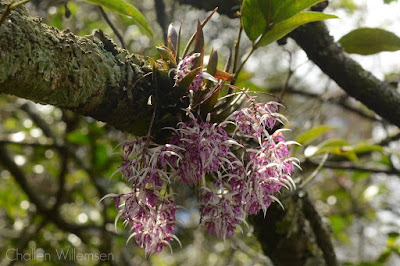Macroclinium bicolor is native to Mexico, Guatemala, El Salvador and Costa Rica. In Guatemala, these plants grow on trees in forests at an altitude of 1460 m...
Macroclinium bicolor also called as The Two-Colored Macroclinium, Notylia bicolor, is a species of the genus Macroclinium. This species was described by Dodson in 1984.
IDENTIFY MACROCLINIUM BICOLOR
Macroclinium bicolor is native to Mexico, Guatemala, El Salvador and Costa Rica. In Guatemala, these plants grow on trees in forests at an altitude of 1460 m. They were found in several places near the city of Guatemala and in several others in the region. In El Salvador, they were found at Cerro Grande de Apaneca at an altitude of 1700 m.
It is a mini-miniature sized, cool to hot growing fan shaped, twig epiphyte, which reaching 5 cm in height, with no or minute ovoid, compressed, 0.5-1 cm long and about 0.5 cm wide pseudobulbs that are subtended by 4 to 6, equitant imbricate, oblique, lanceolate to ovate-lanceolate, acute, ancipitous, fleshy, foliaceous sheaths, each carrying a single, reddish to green, 1.5-5.0 cm long and 0.4-1.0 cm wide leaf.
The Two-Colored Macroclinium blooms in the summer on a pendulous, 10 cm long, many flowered inflorescence. The flowers are 1.8 cm long and narrow, pointed stems of both whorls that do not open completely. The petals of both whorls are white, but the petals of the inner whorl have dark purple spots. The lip is whitish-purple with a pair of darker, purple spots on the dial.
MACROCLINIUM BICOLOR CARE AND CULTURE
Cultural information should only be used as a guide, and should be to be adapted to suit you. Your physical location; where you grow your plants, how much time you have to devote to their care, and many other factors, will need to be taken into account. Only then can you decide on the cultural methods that best suit you and your plants.
Light:
Macroclinium bicolor needs a light level of 12000-20000 lux. These plants need filtered or scattered light and protection from direct sunlight. Strong air movement should be ensured all the time.
Temperature:
It is a plant with moderate thermal requirements. The average summer temperature in the summer is 25 ° C, the average night is 15 ° C, which gives a daily amplitude of 10 ° C. The average winter temperature is 22-23 ° C during the day and 11-12 ° C at night, giving a diurnal difference of 9-12 ° C.
Humidity:
The Two-Colored Macroclinium needs the humidity of 75-80% for most of the year, in winter for a month or more it drops to around 70%.
Substrate, growing media and repotting:
Macroclinium bicolor grows best firmly attached to washers from pieces of tree fern. However, such plants require high humidity, and during hot and dry weather, they should be watered several times a day.
They can also be grown in small pots or baskets using a very airy, fast-drying substrate, which decomposes slowly. These plants are very sensitive to any manipulations, so you should overdo them as little as possible. A good substrate for these plants is cut wood fiber ferns with the addition of chopped sphagnum moss and pieces of pearlite, which provide the substrate with a loose structure, breathability and retain some moisture. The addition of charcoal also helps to keep the substrate cool and prevents it from getting sour.
The plants should be repotted immediately after noticing signs of substrate decomposition, or every few years when the plant grows out of the pot. If repotting is done at the time when new roots begin to appear, the plant will be accepted and rooted in the shortest possible time.
Watering:
The plants should be watered abundantly during periods of intensive growth, but excellent drainage should be ensured so that the ground around the roots is never spread or soggy. When new growths reach maturity in the autumn, the amount of water should be reduced.
Fertilizer:
During the active growth, the plants should be fertilized every week 1/4-1/2 of the recommended dose of fertilizer for orchids. You can use sustainable fertilizer throughout the year. You can also use high-nitrogen fertilizer from spring to mid-summer, passing in late summer and autumn to high phosphorus fertilizer.
Rest period:
Macroclinium bicolor require less water in winter, but should not be dry for a longer period. Quite frequent morning fogging between rare, light watering should provide enough moisture, while allowing the necessary dry rest. Fertilization should be reduced or eliminated until new growths appear and a more abundant spring watering begins.















COMMENTS